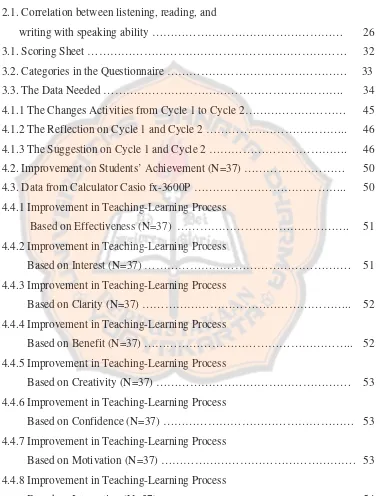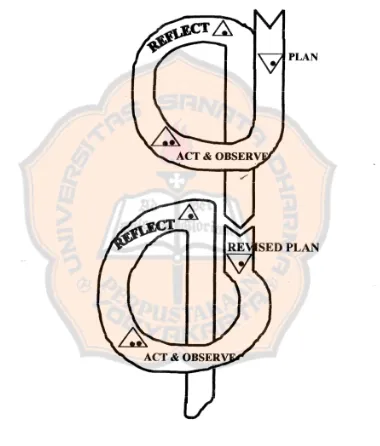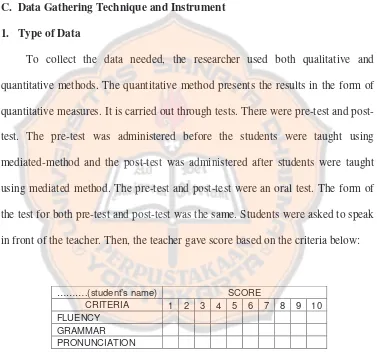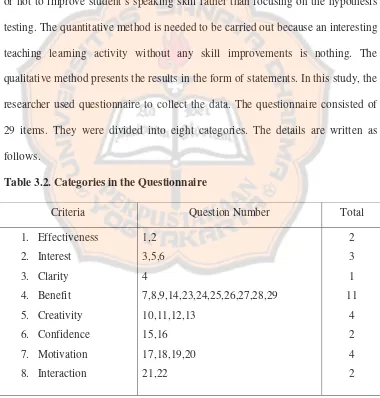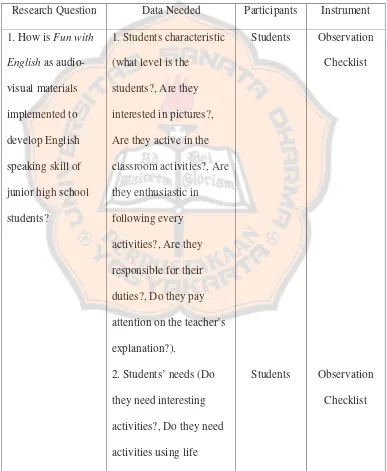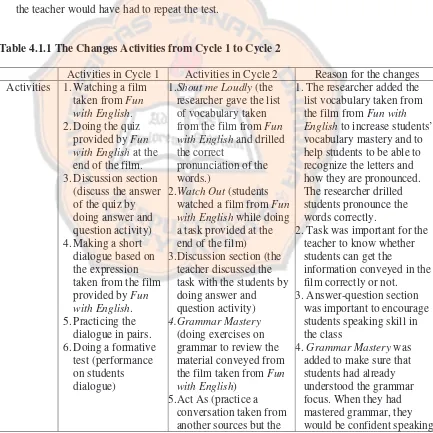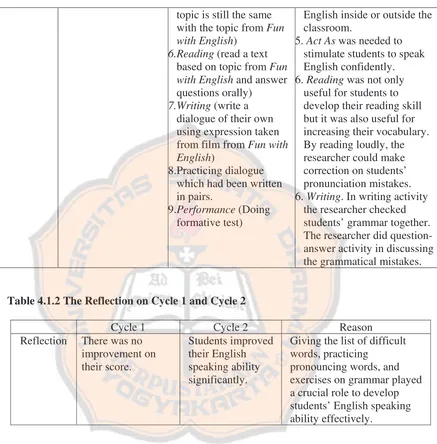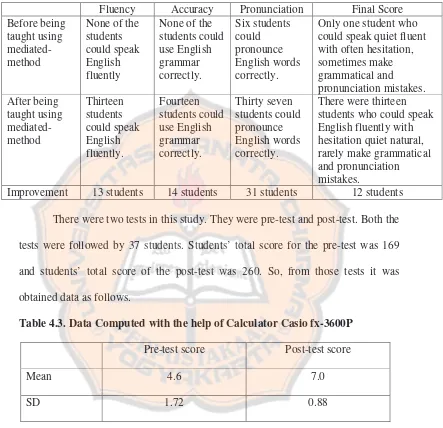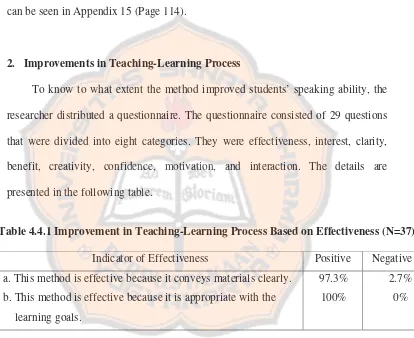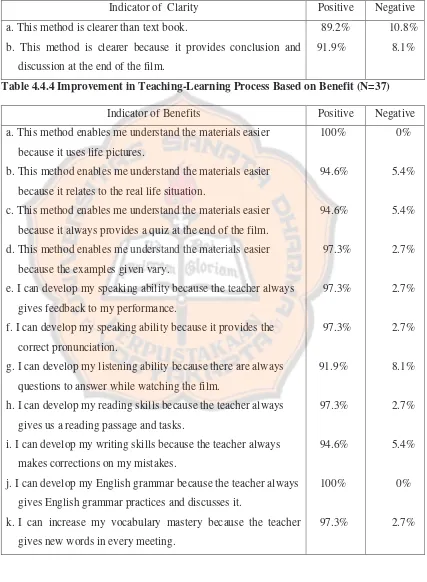USING FUN WITH ENGLISH AS AUDIO-VISUAL MATERIALS TO DEVELOP SPEAKING SKILL OF JUNIOR HIGH SCHOOL
STUDENTS
A THESIS
Presented as Partial Fulfillment of the Requirements to Obtain the Sarjana Pendidikan Degree
in English Language Education
By
Frida Purusadani
Student Number: 051214077
ENGLISH LANGUAGE EDUCATION STUDY PROGRAM DEPARTMENT OF LANGUAGE AND ARTS EDUCATION FACULTY OF TEACHERS TRAINING AND EDUCATION
SANATA DHARMA UNIVERSITY YOGYAKARTA
AThesis on
USING FUN WITH ENGLISH AS AUDIO-VISUAL MATERIALS TO DEVELOP SPEAKING SKILL OF JUNIOR HIGH SCHOOL
STUDENTS
By Frida Purusadani Student Number: 051214077
Approved by
Sponsor
Gregorius Punto Aji, S.Pd., M.Hum. May 15, 2010
AThesis on
USING FUN WITH ENGLISH AS AUDIO-VISUAL MATERIALS TO DEVELOP SPEAKING SKILL OF JUNIOR HIGH SCHOOL
STUDENTS
By Frida Purusadani Student Number: 051214077
Defended before the Board of Examiners on May 6, 2010
and Declared Acceptable
Board of Examiners
Chairperson : C. Tutyandari, S.Pd., M.Pd. __________________
Secretary : Made Frida Yulia, S.Pd., M.Pd. __________________
Member : G. Punto Aji, S.Pd., M.Hum. __________________
Member : C. Tutyandari, S.Pd., M.Pd. __________________
Member : Dr. Retno Muljani, M.Pd. __________________
Yogyakarta, May 6, 2010
Faculty of Teachers Training and Education Sanata Dharma University
Dean,
Drs. Tarsisius Sarkim, M.Ed., Ph.D., Ph.D.
I dedicate this thesis to
My Almighty God, Jesus Christ,
My beloved parents, sisters, and brother, and
My lovely friends wherever they are.
STATEMENT OF WORK’S ORIGINALITY
I honestly declare that this thesis, which I have written, does not contain the work or parts of the work of other people, except those cited in the quotations and references, as a scientific paper should.
Yogyakarta, May 10, 2010 The writer
Frida Purusadani 051214077
LEMBAR PERNYATAAN PERSETUJUAN
PUBLIKASI KARYA ILMIAH UNTUK KEPENTINGAN AKADEMIS
Yang bertanda tangan di bawah ini, saya mahasiswa Universitas Sanata Dharma:
Nama : Frida Purusadani
Nomor Mahasiswa : 051214077
Demi pengembangan ilmu pengetahuan, saya memberikan kepada Perpustakaan
Universitas Sanata Dharma karya ilmiah saya berjudul:
USING FUN WITH ENGLISH AS AUDIO-VISUAL MATERIALS TO DEVELOP SPEAKING SKILL
OF JUNIOR HIGH SCHOOL STUDENTS
beserta perangkat yang diperlukan (bila ada). Dengan demikian saya memberikan
kepada Perpustakaan Universitas Sanata Dharma hak untuk menyimpan,
mengalihkan dalam bentuk media lain, mengelolanya dalam bentuk pangkalan
data, mendistribusikannya secara terbatas dan mempublikasikannya di Internet
atau media lain untuk kepentingan akademis tanpa perlu meminta ijin dari saya
maupun memberikan royalti kepada saya selama tetap mencantumkan nama saya
sebagai penulis
Demikian pernyataan ini yang saya buat dengan sebenarnya.
Dibuat di Yogyakarta
Pada tanggal: 20 Mei 2010
Yang menyatakan
Frida Purusadani
ABSTRACT
Purusadani, Frida. 2010. Using Fun with English as Audio-Visual Materials to Develop Speaking Skill of Junior High School Students. Yogyakarta: English Language Education Study Program, Sanata Dharma University.
Speaking skill in English is important for everyone who studies English, especially students in junior and senior high schools. However, students’ speaking skill is low, for example, students of SMP N 4 Ngaglik. From an observation in the classroom, it was revealed that the causes were the lack of practices and interactive activities, the lack of motivation and interest, the lack of confidence and media, and the use of conventional method. Theoretically, those problems and all related causes can be solved by using audio-visual materials. Audio-visual materials attract students’ attention and interest, increase students’ motivation, and build interaction. Here, the researcher chose Fun with English. It is visual and auditory materials using live pictures. It uses natural language, fulfills the bidirectional learning, meets students’ needs based on the curriculum, and facilitates the integrated teaching learning process. Because Fun with English
covers all students’ needs, it is important to implement the use of Fun with English to develop students’ speaking skill through research.
This research was a Classroom Action Research which aims to solve students’ problems related to the low mastery of speaking skill. There are two problems to solve in this research. First, how is Fun with English as audio-visual materials implemented to develop English speaking ability of junior high school students? Second, how does Fun with English as audio-visual materials improve the English speaking ability of junior high school students? To answer the first research problem, the researcher observed the seventh grade students of SMP 4 Ngaglik behaviors and attitudes during the teaching learning process using classroom observation checklist. Meanwhile, to answer the second research problem the researcher used questionnaire as the instrument. The researcher also employed hypothesis testing (based on score of pre test and post test) to know the improvement of the students’ achievement. The procedure of the implementation of Fun with English to develop students’ English speaking skill was as follows: plan, action and observation, reflection.
The implementation of the use of Fun with English to develop speaking skill of junior high school students was done in two cycles. In the first cycle, the researcher implemented the use of Fun with English only. There were six activities in this cycle. They were watching a film taken from Fun with English,
doing a quiz taken from Fun with English, discussing the answer, making a short dialogue using the expressions taken from Fun with English, practicing the dialogue in pairs, and conducting a formative test. The result of the first cycle was that there was no improvement in students speaking skill. In the second cycle, there were nine activities. They were Shout me Loudly (drilling pronunciation taken from Fun with English), Watch Out (watching a film taken from Fun with
English), discussion, Grammar Mastery (doing exercises on grammar), Act As
(practicing conversation), Reading (reading a text based on topic from Fun with English), practicing the dialogue in pairs, Performance (conducting a formative test). The result of the second cycle was that students made some progress on their speaking skill. From the questionnaire, it was found that the use of Fun with English was effective. It was motivating, encouraging, clearer, more interesting, more understandable, more useful, and builds students’ confidence and interaction. From the hypothesis testing, it was found that the standard deviation of post-test (0.88) was lower that the standard deviation of pre-test (1.72). It means that the improvement is significant and it makes students skill more homogeneous.
There were several suggestions proposed based on the results of the study. The first suggestion was for teachers. They might use these research findings to make some progress on their students’ achievements by adding several communicative activities. The second suggestion was for readers, especially would-be teachers. They might use these research findings for various educational purposes. The last suggestion was for other program developers. They should add several activities which make students active, creative, and interactive if they are going to create audio-visual learning materials.
ABSTRAK
Purusadani, Frida. 2010. Using Fun with English as Audio-Visual Materials to Develop Speaking Skill of Junior High School Students. Yogyakarta: Program Studi Pendidikan Bahasa Inggris, Universitas Sanata Dharma.
Keahlian berbicara dalam Bahasa Inggris sangatlah penting bagi siapa saja yang belajar Bahasa Inggris, terutama bagi siswa SMP dan SMA. Akan tetapi, keahlian berbicara Bahasa Inggris siswa rendah. Sebagai contoh, keahlian berbicara Bahasa Inggris siswa SMP N 4 Ngaglik. Dari hasil pengamatan di kleas, terungkap bahwa penyebabnya adalah tidak adanya latihan-latihan berbicara dan aktifitas interaktif, tidak adanya motivasi belajar dan ketertarikan terhadap mata pelajaran Bahasa Inggris, hilangnya rasa percaya diri siswa, tidak adanya media pendukung, dan penggunaan metode konvensional. Secara teori, masalah-masalah dan semua penyebab tersebut dapat diatasi dengan menggunakan materi pembelajaran audio-visual. Materi pembelajaran audio-visual mampu menarik perhatian dan minat siswa, meningkatkan motivasi, dan mampu membangun interaksi siswa. Di sini, penulis memilih Fun with English sebagai media yang diterapkan. Fun with English adalah materi pembelajaran audio visual yang menngunakan gambar bergerak. Fun with English menggunakan bahasa yang sederhana, mencakup pembelajaran dua arah, mencakup kebutuhan siswa sesuai dengan kurikulum, dan memfasilitasi siswa untuk belajar secara integrative. Karena
Fun with English mencakup semua kebutuhan siswa dalam belajar Bahasa Inggris, maka penting untuk menerapkan media ini untuk mengembangkan keahlian berbicara siswa melalui penelitian.
Penelitian ini adalah Penelitian Tindakan Kelas yang bertujuan untuk menyelesaikan masalah siswa berkaitan dengan rendahnya penguasaan keahlian berbicara Bahasa Inggris. Ada dua masalah yang diselesaikan melalui penelitian ini. Pertama, bagaimana
Fun with English sebagai materi audio visual diterapkan untuk mengembangkan keahlian berbicara Bahasa Inggris siswa SMP? Kedua, bagaimana Fun with English
sebagai materi audio visual dapat meningkatkan keahlian berbicara Bahasa Inggris siswa SMP? Untuk menjawab masalah penelitian yang pertama, peneliti mengamati perilaku dan sikap siswa kelas tujuh SMP N 4 Ngaglik selama mengikuti proses belajar mengajar Bahasa Inggris. Pengamatan ini dilakukan dengan menggunakan daftar pengamatan kelas. Sedangkan untuk menjawab masalah penelitian yang kedua, peneliti menggunakan kuesioner sebagai instrumennya. Peneliti juga menerapkan hypothesis testing (berdasarkan nilai pre-test dan post-test) untuk mengetahui seberapa besar peningkatan prestasi belajar siswa. Langkah-langkah penerapan Fun with English untuk mengembangkan keahlian berbicara Bahasa Inggris siswa adalah sebagai berikut: perencanaan, tindakan dan observasi, refleksi.
Penerapan penggunaan Fun with English untuk mengembangkan keahlian berbicara Bahasa Inggris siswa SMP dilakukan dalam dua putaran. Putaran yang pertama adalah penggunaan hanya Fun with English. Ada enam aktifitas pada putaran ini. Aktifitas-aktifitas tersebut antara lain: menonton film yang diambil dari Fun with English, mengerjakan kuis, berdiskusi, membuat percakapan pendek menggunakan
ekspresi yang diambil dari Fun with English, mempraktekkan percakapan yang dibuat, dan melaksanakan tes formatif. Hasil dari putaran pertama adalah bahwa siswa tidak mengalami peningkatan pada keahlian berbicara Bahasa Inggris mereka. Pada putaran ke dua, ada sembilan aktifitas yang dilakukan. Aktifitas-aktifitas tersebut antara lain:
Shout me Loudly (melatih siswa mengucapkan kata-kata Bahasa Inggris yang diambil dari Fun with English), Watch Out (menonton film yang diambil dari Fun with English), berdiskusi, Grammar Mastery (mengerjakan latihan-latihan tata bahasa), Act As (mempraktekkan percakapan), Reading (membaca teks berdasarkan topic dari Fun with English), mempraktekkan percakapan secara berpasangan, Performance
(melaksanakan tes formatif). Hasil dari putaran kedua adalah siswa mengalami peningkatan pada keahlian berbicara Bahasa Inggris mereka. Dari hasil analisa kuesioner, ditemukan bahwa penggunaan Fun with English sangatlah efektif. Fun with English mampu memotivasi siswa, mendorong siswa, lebih jelas dalam menyampaikan materi, lebih menarik, lebih mudah dipahami, lebih menguntungkan, dan dapat membangun rasa percaya diri dan interaksi siswa. Dari hasis hypothesis testing, diperoleh data bahwa standar deviasi pre-test (0.88) lebih rendah daripada standar deviasi post-test (1.72). Ini berarti bahwa peningkatan yang terjadi pada siswa adalah signifikan dan metode ini juga mampu menyeragamkan keahlian siswa.
Berdasarkan hasil penelitian, ada beberapa usulan yang diajukan. Usulan pertama ditujukan kepada para guru. Para guru dapat menggunakan hasil-hasil penelitian ini untuk meningkatkan prestasi belajar siswa mereka dengan menambahkan aktifitas-aktifitas yang komunikatif. Usulan yang kedua ditujukan kepada para pembaca, khususnya para calon guru. Para calon guru dapat menggunakan hasil-hasil penelitian ini untuk tujuan-tujuan pendidikan. Usulan yang terakhir ditujukan kepada para pengembang materi pembelajaran. Para pengembang materi pembelajaran sebaiknya melengkapi materi pembelajran audio visual mereka dengan aktifitas-aktifitas yang membuat siswa aktif, kreatif, dan interaktif.
ACKNOWLEDGEMENTS
I am very grateful to Jesus Christ who is faithfully leading me and
blessing me every time, everywhere, and everyday so that I could finish this
thesis. I realize that all I have done can not be apart from God’s blessing. Without
God’s blessing, I could not do anything.
I would like to sincerely thank Gregorius Punto Aji S.Pd, M.Hum., my sponsor, for every suggestion and assistance. I would like to give my very special
word gratitude for my beloved parents: Drs. G. Suharto, M.Pd and Veronika Tuginah for their love, affection, support, prayer, and everything. I would also like to thank them for always cheering up my life, encouraging me when I am
down, and understanding my feeling. I would also never forget to thank them for
every suggestion given for the better of my life.
I would like to thank my lovely sisters and brother: Irmina Riris Widiastuti, S.E, Maria Arum Puspita Prihatmi, S.E; and Yohanes Magna Hariarto, S.Pd; who always cheer me up every time I feel sad and encourage me every time I feel desperate and feel disappointed with myself.
I greatly appreciate all the members of SMP 4 Ngaglik, Sleman,
especially for the seventh year students (class C); Wakijo, S.Pd, the principal;
Isniati, S.Pd, the English teacher; classroom teachers; and all the staffs. They have helped me finishing this research.
I would like to thank all lecturers of Sanata Dharma University who
taught me from the first time I studied in this university until the end of my time
to be one of the students here, for the patience and willingness in giving me
knowledge. All lecturers in this university are great and unforgettable.
I would like to express my appreciation to all my friends who have
helped me from the beginning of semester 1 to the end of semester 3; Beni, Ayuni, Retno, Agnes, Olive, and all my classmates from semester 1 to 7. I would also like to thank them for our friendship and their willingness to share knowledge
so we grow together up to this level.
I would also like to give my special thankfulness to my best friends:
Oki, Eka, Lia, Dewi, and Titin who always support me psychologically so that I always have spirit to finish my study. I would never forget to thank my best
friends: Taju, Nita, Dian, and Nancy for always making me laugh, tough, and brave to face every problem in my life. I would also like to thank all Spring
members: Koko, Fandi, Yason, Thomas, and Andre who also played an important role in my study.
I thank all my English private students who I cannot mention one by
one. They are my future. Because of them, I have the opportunity to always
sharpen my saw and keep it bright. They are my wonderful students.
Last but not least, I would also send my gratitude to my guardian angel
who always accompanies, loves, and protects me.
Frida Purusadani
TABLE OF CONTENTS
PAGE
TITLE PAGE ……….. i
APPROVAL PAGES……… ii
DEDICATION PAGE ……… iv
STATEMENT OF WORK’S ORIGINALITY ……… v
ABSTRACT ……… vii
ABSTRAK ……… ix
ACKNOWLEDGEMENTS ………... xi
TABLE OF CONTENTS ……… xiii
LIST OF TABLES ……….. xvi
LIST OF FIGURES ………. xvii
LIST OF APPENDICES ………. xviii
CHAPTER 1 INTRODUCTION ………. 1
A. Research Background ………... 1
B. Problem Formulation ……… 6
C. Problem Limitation ……… 7
D. Research Objectives ………. 7
E. Research Benefits ………... 7
F. Definition of Terms ……… 8
CHAPTER II REVIEW OF RELATED LITERATURE ………... 12
A. Theoretical Description ………. 12
1. Audio-Visual Materials ………. 12
2. Development of Speaking Ability ………... 13
3. Communicative Language Teaching ……….. 15
4. CALL ………. 16
5. Effective Learning ……… 17
6. Classroom Action Research ………. 19
B. Theoretical Framework ………. 24
CHAPTER III RESEARCH METHODS ……….. 28
A. Research Method ……… 28
B. Research Participants ……… 31
C. Data Gathering Technique and Instrument ……… 32
1. Type of Data ………. 32
2. Data Needed ………. 34
D. Data Analysis Technique ……….. 36
E. Research Procedure ……….. 38
CHAPTER IV RESEARCH FINDINGS ……….. 41
A. The Implementation of the Audio-Visual Material to Develop Students’ Speaking Ability ………. 41
1. Cycle 1 ……… 41
2. Cycle 2 ……… 42
B. Students’ Improvement in English Speaking Ability ………... 47
1. Improvement on Students’ Achievement ……… 47
2. Improvements in Teaching-Learning Process ……… 51
CHAPTER V CONCLUSION ……… 56
A. Conclusion ………... 56
B. Recommendations ……….. 57
C. Suggestions ……….. 58
REFERENCES ….………... 60
LIST OF TABLES
PAGE
Table
2.1. Correlation between listening, reading, and
writing with speaking ability ……… 26
3.1. Scoring Sheet ……… 32
3.2. Categories in the Questionnaire ……… 33
3.3. The Data Needed ………. 34
4.1.1 The Changes Activities from Cycle 1 to Cycle 2……… 45
4.1.2 The Reflection on Cycle 1 and Cycle 2 ……….. 46
4.1.3 The Suggestion on Cycle 1 and Cycle 2 ………. 46
4.2. Improvement on Students’ Achievement (N=37) ……… 50
4.3. Data from Calculator Casio fx-3600P ……….. 50
4.4.1 Improvement in Teaching-Learning Process Based on Effectiveness (N=37) ………. 51
4.4.2 Improvement in Teaching-Learning Process Based on Interest (N=37) ………. 51
4.4.3 Improvement in Teaching-Learning Process Based on Clarity (N=37) ……….. 52
4.4.4 Improvement in Teaching-Learning Process Based on Benefit (N=37) ……….. 52
4.4.5 Improvement in Teaching-Learning Process Based on Creativity (N=37) ………. 53
4.4.6 Improvement in Teaching-Learning Process Based on Confidence (N=37) ……… 53
4.4.7 Improvement in Teaching-Learning Process Based on Motivation (N=37) ………. 53
4.4.8 Improvement in Teaching-Learning Process Based on Interaction (N=37) ………. 54
LIST OF FIGURE
PAGE
Figure
2.1 Action Research cycle by Stephen Kemmis ………... 22
LIST OF APPENDICES
PAGE
Appendix 1 Syllabus ………... 62
Appendix 2 Lesson Plan ………... 66
Appendix 3 Student’s Handouts ……… 72
Appendix 4 Teacher’s Handouts ……… 86
Appendix 5 Questionnaire for the students ……….. 100
Appendix 6 The Result of the questionnaire ……… 103
Appendix 7 Classroom Observation Sheet before students were taught using mediated-method …….. 106
Appendix 8 Classroom Observation Sheet after students were taught using mediated-method ………. 107
Appendix 9 Classroom Observation Sheet when students were being taught using mediated-method ………... 108
Appendix 10 Question Sheet of Pre-test ……….. 109
Appendix 11 Question Sheet of Post-test ………. 110
Appendix 12 Pre-test Score ………... 111
Appendix 13 Post-test Score ………. 112
Appendix 14 Scoring Criteria ………... 113
Appendix 15 Hypothesis Testing Result ……….. 114
CHAPTER I INTRODUCTION
This chapter discusses the background of the study which is explained
broadly in the rationale. It also discusses the problem formulation, problem
limitation, research objectives, research benefits for teachers, students, and for
researchers, and definition of terms used in the study.
A. Research Background
English is not only used in educational fields but also in work fields. Many
books which are used in educational fields are written in English, and even poems,
novels, and comics are also written in English. English is used as an international
language in the world. Also, it is used as an instructional language in some
schools in Indonesia. Recently, there are many elementary schools, senior high
schools, and junior high schools are growing to be international schools in which
English is used as the instructional language for every subject the students take.
Some elementary schools, junior high schools, and senior high schools choose one
day to be an English day. It shows that English is now being an important
language in Indonesia.
Therefore English is formally taught at school for children starting from
kindergarten and informally taught at home starting from baby period. A mother,
who gives a birth, tries to collect English songs for her baby as a lullaby because
she wants to make her babies accustomed to English words. She expects her
she wants to make her babies accustomed to English word. She expects her
children will be easier in mastering English when they have to start to learn
English in school. Parents who have children in a kindergarten school, in a junior
high school, and in a senior high school also try to find an English course or
private English course for the sake of their children’s mastery and fluency in
English.
Everyone is suggested to be able to speak English fluently. Why speaking?
It is because speaking plays a crucial role in building a communication. Shannon
and Weaver (1949) state: “As part of social behavior, communication is any
means by which one person or creature brings about a change in the knowledge or
behavior of another person or creature.” Also, they said that communication is
sending and receiving messages. It means that we need a good sender and a good
receiver in building a good communication. Good senders are those who can
transmit their message orderly and clearly. Good receivers are those who
understand clearly the transmitted message. It means that in building a good
communication, we need good speaking skills and good listening skills.
For many people, being fluent in speaking English is not easy since English
is not our mother tongue. They should develop their four basic skills to master it.
They are listening, speaking, reading, and writing. Nevertheless, developing only
four basic skills is not enough. People should also develop the other skills like
pronunciation mastery, vocabulary mastery, and grammar mastery. Frequently,
cannot reply those using English. It seems that they are afraid of making mistakes
and they are not confident enough with their ability in speaking English. It might
happen because they lack practices inside or outside the classroom.
Whereas speaking skill can be said to be good indicators of success in
learning English, we see the fact that English speaking ability of junior high
school students, especially those which are located in small cities or remote
places, shows unsatisfying results. The example of this case is SMP 4 Ngaglik
Sleman. When the researcher discussed this case with the English teacher of the
seventh grade, she said that it was true that her students’ English speaking ability
was not good. It was because students never practice speaking English. She also
explained that the school did not have interesting and effective media to develop
the students’ speaking skill. She also said that she only used textbooks in her
teaching learning activity so there were not many interactive activities to be used.
In fact, the school has a laboratory with a television and VCD player which is
very useful to support the teaching learning activity but the school does not have
recorded materials so the teachers cannot take advantage of them. Because the
teacher only uses the conventional method, consequently the students often get
bored and less interested in the teaching-learning process. They tend to think that
English is difficult and complicated.
When the researcher tried to introduce students to Fun with English, the
researcher observed their attitudes and behaviors during the lesson and the
activity. The teacher was also interested in implementing it. Then the researcher
asked students about their feeling after being taught using Fun with English.
Almost every student said that they were more enthusiastic, happier, and easier in
understanding the materials given. Knowing such a condition, the researcher
concluded that using media in teaching English is crucial because it can attract
students’ attention and interest. It also helps students to know the real situation so
that they can practice it without any hesitation. But, the researcher is not really
sure about this because it was the first time for them to learn with Fun with
English. Since the researcher did it only once, she needs to do the study of using
Fun with English more intensively.
Japanese National Commission for Unesco (1971) stated, “audio-visual
materials play a unique role in conveying what is hard to transmit through
textbooks and present in the classroom lesson.” Audio-visual materials are better
than textbooks in terms of expressing or communicating messages. It is clearer
and more understandable. It is also said by Edling and Paulson (1980) that
instructional media play a key role in the design of systematic instruction because
they establish learners to acquire knowledge, skills, and attitudes from the
condition that is produced.
It means that audio-visual materials are important and effective to be
implemented in improving students’ achievement in English because it shows the
real situation related to the topic so that students get the exact ideas and there will
understanding. If the students do not really understand the material, they are still
able to guess the meaning of the words by paying attention on what is done by the
pictures they watch. It enables learner to acquire knowledge, skills, and attitudes
effectively.
Besides, the success of using media does not only depend on the students,
but also on the teachers, methods, and the school environment. Teachers using
conventional method, in which only teachers play a big role in teaching learning
process, will block the students’ creativity in exploring their ideas and make them
become passive students because they do not have chance or time to practice
speaking and show their ability in the class. In contrast, teachers using
mediated-method in teaching learning process will enable students to explore their creativity
and build their confidence to show their ability in the class. It also makes students
become active because they have much more time and chances to move and speak
up in the class or in the public.
Realizing the benefits of using a recorded material, the researcher chose Fun
with English as the media to help students of SMP N 4 Ngaglik Sleman develop
their speaking ability. Fun with English is an audio visual material which is
recorded in the form of compact disc (CD). The researcher chose elementary level
because seventh grade means the first grade for students to develop their speaking
ability so elementary level is appropriate to be implemented. The researcher chose
Fun with English because it meets the students’ need as stated in the curriculum,
the integrated teaching learning. The researcher thinks it is appropriate to be
implemented in this school because it has the television and the VCD player. It
also has students in low intelligence so that the researcher wants to help them
catch up from the middle and high-intelligent students. This study will be done in
collaboration between the English teacher and the researcher. The material was
designed by the researcher with the help of the teacher, and then it was
implemented. It is aimed to make the learning more effective and more efficient.
By implementing Fun with English, the teachers are expected to be able to use it
as their effective way to develop their students’ speaking ability because speaking
is used as the best indicator of the success in language learning. It is also expected
that the students will be fluent in speaking English after being taught using Fun
with English so that they are ready to continue their study in the higher levels and
ready in facing the global era.
B. Problem Formulation
There are two problems that will be answered through this study. They are:
1. How is Fun with English as audio-visual materials implemented to
develop English speaking skill of junior high school students?
2. How does Fun with English as audio-visual materials improve the English
C. Problem Limitation
Because the researcher wants to apply mediated-method to improve English
speaking ability of junior high school students, teaching method implementation
is the area limitation of this study. Here, the researcher uses pictures as the media.
Pictures are divided into two. They are still picture and live picture. Fun with
English uses live pictures in conveying the materials given. That is why the
researcher gives limitation only on the using of live pictures.
D. Research Objectives
The objectives of the study are:
1. To describe how Fun with English can be implemented effectively to
improve student’s speaking skill.
2. To describe the good impacts Fun with English gives in improving English
speaking skill for junior high school students.
E. Research Benefits
This research is conducted to give some benefits for the teachers of junior
high schools, for the students of junior high schools, and for the researcher.
1. The teachers of junior high schools
This research helps them improve the learning achievement of speaking skill
of junior high school students. It is also expected that speaking skill of students
also helps teachers to know whether Fun with English is effective to develop the
junior high school students' speaking ability.
2. The students of junior high schools
Through the implementation of the use of Fun with English, students are
expected to be able to understand the material easier because they are interested in
the teaching learning process. It is also expected that the students’ speaking skill
will improve significantly after being taught using Fun with English so that they
become fluent in speaking English.
3. The researchers of this study
The researcher of this study hopes that Fun with English could be
implemented successfully to improve speaking skill of junior high school
students. The researcher also wants to help English teachers of junior high schools
provide an interesting and effective media for their English teaching-learning
activities. Besides, through the implementation of the use of Fun with English the
researcher will know will know to what extent Fun with English develops English
speaking skill of junior high school students.
F. Definition of Terms
The terms used in this study are defined as follows.
1. Fun with English
Fun with English is a film. It is a visual and auditory English learning
focuses on the development of learners’ speaking skill. It is an English learning
medium which is interesting, practical, and easy to understand starting from
pre-elementary to advance. It is developed by experts, professionals, and native
speakers who systematically work together applying a modern English learning
method. It consists of four categories. They are pre-elementary (pre-school to 6
years old), elementary (7 years old to 12 years old), intermediate (13years old to
16 years old) and advanced (students of university). Fun with English provides
grammar, vocabulary, phonetic, and six basic skills in learning a language, that is
watching, listening, understanding, speaking, reading and writing.
2. Audio-Visual Materials
Japanese National Commission for Unesco stated in “The Use of
Audio-Visual Teaching Materials in Schools in Japan”, published in 1971, that
audio-visual materials can be defined as “audio-visual and auditory media for the education of
elementary and lower secondary school pupils.” There are many kinds of
audio-visual materials, such as films, movies, overhead projectors, and pictures.
Huebener (1960:3) stated: “The use of audio-visual materials and methods
increase the effectiveness of learning by helping the pupil to assimilate ideas in a
more meaningful and interesting manner”. Through eye and ear, audio-visual
materials can improve students’ knowledge and skill. Audio-visual materials
accomplish effectively most objectives of education if it is planned, concentrated,
completed by using a good devices. The proper use of audio-visual materials
communication, encourage pupil participation, and provide for group thinking and
planning.
Kinder (1965:7) said,” Audio-visual materials can be more than helpers.
They can be actual learning materials in their own right, and they should never be
considered merely secondary or auxiliary tools”. Audio-visual materials should
become initial tools for students. It is very important to have such materials
because students will be very helpful in improving their achievements through
this media. Audio-visual materials present the intended situations in which
students could get the exactly meaning of the messages being conveyed. Students
will know the actual information which wants to be delivered.
The importance rule of audio-visual materials also stated by Wittich and
Schuller (1953:13), they said
“One important means by which instruction can be improved is to be found within area of audio-visual materials and techniques and their relationship to be more effective accomplishment of the modern school curriculum”.
Audio-visual materials will be effectively used if they accomplish by
appropriate teaching techniques. This compilation will improve the quality of the
teaching learning process. It will also give good impacts for students in their
development of their skills, knowledge, and achievements. That is why modern
school curriculum used audio-visual materials to be one of their sources or initial
3. Speaking Skill
What is meant by speaking skill here is the ability to express meaning using
simple spoken language accurately, fluently, and acceptable in the transactional
and interpersonal to communicate with the closest environment and or academic
contexts using the expression of asking and giving information, saying gratitude,
asking and giving forgiveness, and expressing politeness (Standar Kompetensi
Lulusan Mata Pelajaran Bahasa Inggris SMP-SBI 2007).
4. Junior High School Students of SMP N 4 Ngaglik
Junior high school students are students in the grade of seven to nine. They
extend from the age of twelve to fourteen. SMP N 4 Ngaglik Sleman is the most
favorite junior high school in Ngaglik sub-district. It is located at Palagan Tentara
Pelajar Street Km. 9. It has nine classes. Each class consists of forty students. The
7th year consists of three classes as well as the 8th and the 9th year do. The class
division is based on the students' intelligence. Students of high intelligence are
placed in Class A, students of middle intelligence are placed in Class B, and
students of low intelligence are placed in Class C. SMP N 4 Ngaglik Sleman has a
biology lab which provides a television and a VCD player. It also has a computer
lab, a “pendopo” that is used to conduct dancing class, a “mushola” (small
CHAPTER II
REVIEW OF RELATED LITERATURE
Talking about the implementation of using Fun with English to develop
speaking skills of seventh-year students means that we have to know the theory of
audio-visual materials, the development of speaking ability, communicative
language teaching, the theory of computer-assisted language learning, the
effective learning, and classroom action research. This chapter will discuss them
clearly.
A. Theoretical Description 1. Audio-Visual Materials
Audio-Visual materials are recorded materials using live or motion pictures
which provides experiences which are directly related to the real life situation.
The characteristic of audio-visual materials is that learners can only watch the
pictures and listen to the sounds and they cannot directly contact with the media.
Motion pictures have more benefits than textbooks have in case of presenting the
materials given. Motion pictures present messages clearer than textbooks do. It
also raises students’ interest because they enjoy the media and attracts much more
students’ attention because they have to watch and listen carefully on the video;
otherwise they know nothing about it (The Use of Audio-Visual Teaching
Materials in Schools in Japan, 1971:1-3)
There are three significances of using motion pictures in teaching-learning
activity. First, it can record events as they happen and make the events available
again. Using motion pictures, we can repeat events in the past as if they happened
again in this present. Here, students are supposed to look at the real events so that
they can more understand easily. Second, it motivates students because they enjoy
the medium. Teenagers have a great potential and a great capacity to learn
something interesting for them. They prefer responding situations with their own
thought and experience while watching. They can explore their mind whenever
they look at something they never see before or at something which relates to their
experience. They will memorize it longer than they will do when they only read
textbooks. Third, it can recreate historic events accurately, detailed sets, costumes,
and animation. Historic events already happened in the past when students were
not born yet so it is difficult for them to imagine what was happening through text
only, how the settings are, and what kinds of costumes the people used. Through
motion pictures, we will explicitly present how the events happened, the setting
and the costumes people used when the events happened (The Use of
Audio-Visual Teaching Materials in Schools in Japan, 1971:34).
2. Development of Speaking Ability
Developing speaking skills not only has something to do with fluency but
people also should consider with their speaking ability. Harmer (1989:269) stated
that there are two elements of speaking. The first element is knowledge of
Knowledge of language features includes the ability to produce individual
phoneme, to use fluent connected-speech, expresses devices, lexical and grammar,
and negotiation language. The ability to process information includes language
processing, interacting with others, and on the spot information processing.
Willis (1981:104) suggested several activities that can be used to improve
students’ speaking ability are among others conversation drill, using picture cues,
imaginary situations, and role play. Conversation drill can be done through
dialogues or practice a short conversation containing expressions used in the daily
life situation. Pictures can be used to help students describe objects that impress
them much. It helps them in making statements because students know the detail
parts of the objects so that they will be able to produce a lot of sentences as they
want to say. Imaginary situations can be done through writing a dialogue that
presents situations related to the daily life. Role play trains students being
confident in speaking in front of public. In role play grammar mastery, diction,
spelling, and content become the focus of the learning.
Goh and Silver (2004) added, “Good speaking abilities are also need for
clear expression of ideas and maintaining of interaction.” In building a good
speaking ability, students need to know the effective strategy in learning English
and the other aspect like vocabulary mastery to be able to express their idea
clearly. If they can express that idea clearly, they will be able to maintain
interaction well.
that size and even larger set of vocabulary items that they can comprehend in context.” (Goh and Silver, 2004:121-122)
It means that vocabulary mastery for students is important. Students should master
10.000 English words, at least, to be able to communicate in English. By
mastering a lot of vocabulary in English since they are in the first grade of the
speaking development phase, students will be able to develop their speaking
ability easily when they are in the higher level. That is why giving a list of new
vocabulary or difficult word that relate to the topic is very useful for students.
Learning vocabulary has something to do with pronunciation, stress, intonation,
spelling, and meaning. Drilling is the effective way to complete the learning
activity in this section.
From the discussion above, it can be concluded that elements of speaking
that should be developed among junior high school students are fluency, accuracy,
and acceptability in the daily life context.
3. Communicative Language Teaching
Communicative language teaching uses activities that engage learners’
participation in communicational situations. The activities usually used in
communicative language teaching are dialogues, drilling, and pronunciation
comprehension. Wilkins (1972) described two types of meaning in
communicative uses of language: they are notional categories (time, sequence,
quantity, location, and frequency), and categories of communicative function
(requests, denials, offers, complaints). Littlewood (1981) has distinguished two
a. Functional communication activities that are aimed to develop language
skills which involve communication.
b. Social interaction activities, such as conversation and discussion sessions,
dialogues and role plays.
The objectives of communicative language teaching are:
b. Students will learn to use language as a means of expression.
c. Students will use language as a means of expressing values and judgments.
d. Students will learn to express the functions that best meet their own
communication needs.
The communicative language teaching emphasize on “what to teach” and
“how to teach”. The “what to teach” aspects of the Communicative approach
stressed on the use language forms appropriately in a variety of contexts and for a
variety of purposes. In the “how to teach” of the Communicative approach plenty
of opportunities are important for student’s development of knowledge and skill.
Activities in CLT typically involve students in real or realistic communication.
Thus role-play and simulation have become very popular in CLT. The importance
of the activities here are that students desire to communicate, students have the
purpose for communicating, and students focus on the content they are saying or
writing. (Harmer: 84-85)
4. CALL
Computer-assisted language learning is a rapidly evolving academic field
evolved from a behavioristic model, to communicative and integrative models, to
include finally a more collaborative approach. Supported by the socio-cognitive
view of learning, integrative CALL referred to technology to create authentic
learning environments, which integrated reading, listening, speaking, and writing
skills in a target language. Both integrative and developmental CALL support
highly interactive and communicative language learning. CALL focuses on the
learning. It is a student-centered learning material in which students take more
participation than teachers do. In student-centered learning students are motivated
to be active and more creative. (Woung and Cadierokaplan, 2004: 141)
CALL builds students confidence. The use of media tends to make the class
and the learning more interesting, helps students develop their ability, and
stimulates students’ thought to think creatively in doing their speech or
communication with others. CALL provides an authentic learning. Students can
develop their four basic skills by the help from the native speaker. Students can
use or produce sentences in real communication situation so that they will feel
more confident to communicate with others.
5. Effective Learning
Learning is a process of how we get knowledge, how we develop
knowledge, and how we improve our understanding and skills. Learning does not
only a matter on what score students get but it is more about how students develop
their skill and knowledge. Learning is effective if it focuses on how the students
entertaining teaching learning process. They are happy if they see that their
students enjoy and happy with the way they teach. They often forget about the
way to reach the goal of the learning, the appropriate methods that should be
implemented, and the strategies that should be used to help their students reach
the learning goal.
Effective learningfocuses on how we learn. It gives invaluable insights into on how you can develop your portfolio of skills and knowledge by managing and improving your ability to learn-positively and systematically. Practical exercises and clear guidance are given on:
1. recognizing the importance of “achieved” learning.
2. understanding the learning process-the learning cycle and learning styles preference.
3. taking best advantage of learning opportunities. 4. creating and implementing personal development plan. 5. encouraging and managing a learning culture.
Munford (1999:65) stated that an effective learning provides chances for
students to be able to manage and improve their ability so that they can develop
their skill and knowledge in a positive and systematic way. Here, students need to
recognize the learning achievement they should reach. They should also
understand the learning process which is carried out to help them find their
learning styles preference so that the learning process will be effective and
efficient. If students have the ability to recognize and understand those, they will
also be able to take advantages for every opportunity given by the teachers.
Finally, they can create and implement their own personal development to
encourage their own learning culture for the sake of their success.
In Standar Kompetensi Lulusan Mata Pelajaran Bahasa Inggris SMP-SBI,
learning, group learning, effective learning without any pressure, independent
learning, good model, and creative learning. The indicators of learning
achievement are that students are able to develop their four basic skills during the
process of learning, students are able to use more than one language skill in their
language activity, students are able to build interactions with others in a team
work, students are active and creative in developing their language skill, students
are able to work individually without any pressure, and students are able to
behave intellectually inside or outside classroom.
6. Classroom Action Research
Considering all theories described above, the researcher concludes the
classroom action research can be used as good method to be implemented to
improve the students’ speaking ability. Action research is a group activity
(Kemmis and McTaggart 1988:6). It is done by teachers in their own classroom
which aimed to increase the effectiveness of learning and solve problems in
learning. Action research is problem-focused. It is done in order to solve problems
in education. Personal review is important here. That is why an interview,
questionnaires, and personal reflections are used in collecting the data needed.
Because action research aimed to make improvements in student’s achievement,
teachers not only focus on the materials but also in the activity and practice.
Action research is a form of collective self-reflective enquiry undertaken
by participants in social situations in order to improve the rationality and justice
these practices and the situations in which these practices are carried out. Groups
of participants can be teachers, students, principals, and parents (Stephen Kemmis
and Robin McTaggart: 1992 page 5).
Lewin (1946) described action research as proceeding in spiral of steps, each
of which is composed of planning, action, and the evaluation of the result action.
Planning should be done carefully for the sake of a successful action. In action,
researcher should follow the plan to know whether the activities are effective or
not. To know the effectiveness of the process done in the action, researchers
should evaluate the process. This evaluation can be done through an interview,
questionnaires, or student’s reflection.
In The Action Research Planner, edited by Kemmis and McTaggart
(1992), there are three steps in doing action research: plan, action, observation,
reflection.
a. Plan
The plan is a crucial part in research. A good preparation will result in a
benefit improvement. Plan is preparation section before a researcher does actions.
The activities done in the plan are observing problems in education, finding the
reason why the problems arise, choosing the problems that is needed to be solved
soon, finding the effective solutions to be applied, preparing instrument used in
collecting the data needed, and preparing for the activities which are going to be
used. The problems that are chosen must be critical and risky. It should bring
act more effectively, wisely, and prudentially, so it does not raise new problems.
(Kemmis and McTaggart: 1992 page 12).
b. Action and Observation
Action is guided by planning. In the action section, practitioners do their
plan as they constructed before. The action should reflect what are going to
achieve and what should be achieved. Here, the practitioners apply the method or
strategies they prescribed in the plan. The practitioners teach the class while
observing the situation, the students’ attitudes and behavior in the classroom, and
the learning atmosphere. (Kemmis and McTaggart: 1992 page 12).
Observation has the function of documenting the effects of action. The
observation of the process result can be done through students’ reflection,
interviews, or questionnaires. The careful observation is necessary because action
will always be controlled and organized. Observation should be planned so that
the documentary of sequences is objective, responsive, and open-minded.
(Kemmis and McTaggart: 1992 page 13).
c. Reflection
Reflection is aimed to make the process, problems, and issues become clear.
Reflection has an evaluative aspect. It includes researcher’s experience in order to
judge whether the learning activities give good impacts or not to students’
development. Reflections are also used to give suggestions to the next cycle. In
activities which are going to be done in cycle two. (Kemmis and McTaggart,
1992:13).
There are several key points about action research (Kemmisand McTaggart,
1988:22):
1. Action research is an approach to improve education by changing it and
learning from the consequences of changes.
2. Action research is participatory: it is research through which people work
towards the improvement of their practices.
3. Action research develops through the self-reflective spiral: a spiral of cycles of
planning, acting, observing, reflecting and re-planning, further
implementation, observing and reflecting.
4. Action research is collaborative; it is done in collaboration between others.
5. Action research is a systematic learning process in which people act
deliberately.
6. Action research involves people in their practicing about circumstances,
action, and consequences and to understand the relationship between
circumstances, actions, and consequences in their own lives.
7. Action research puts students’ practices, ideas, and assumptions about the
material given.
8. Action research involves keeping a personal journal in which we record our
progress and our reflections for the sake of the effectiveness of the process.
9. Action research involves people in making critical analyses of the situations
(classrooms, schools, systems) in which they work.
B. Theoretical Framework
The first theory that is used in this study is the theory of Audio-Visual
Materials. Audio-Visual materials are recorded materials using live or motion
pictures which provides experiences which are directly related to the real life
situation. Here, the researcher chose Fun with English because it is a visual and
auditory material using live pictures which presents daily life situations related to
the students’ experience in their daily live. There are several reasons why the
researcher chose Fun with English to develop speaking skill of junior high schools
students. The first reason is Fun with English uses natural language input. The
language that is used is simpler so that students could understand the materials
given easier. The second reason is that live pictures could be good models for
students in developing their speaking ability. It could convey the meaning
authentically so that students could understand the messages accurately. The third
reason is Fun with English facilitates the integrated teaching-learning process as
stated in the computer-assisted language learning. Students could develop their
listening skill integrates with their speaking skill or writing integrates with
speaking skill or reading skill integrates with writing and speaking skill. Besides,
the language activities vary so that students would not be bored in following
lessons. Live pictures and the listening activity train students to watch, read,
listen, write, and speak. Listening and reading activities helped students
understand the meaning of the words and pronounce the words correctly. When
students read the reading passage loudly, the researcher made correction on their
grammatical items could be corrected together so that students know the right
grammar should be used. The last reason is that Fun with English fulfills the
bidirectional learning. Students and the teacher could learn to each other so that
there is a good interaction between students, between students and teachers, or
between teacher and students. Answer and question section, discussion, and
practicing conversation create a good interaction in the classroom so that there
will be a live teaching learning activity. A good interaction in the classroom
shows that the students are active.
Willis (1981:104) suggested several activities that can be used to improve
students’ speaking ability are among others conversation drill, using picture cues,
imaginary situations, and role play. Here, the researcher includes those activities
in her teaching learning activities. Drilling is used to train students pronounce the
English words taken from Fun with English so that students will not be confused
while watching the film. Imaginary situation is presented in writing activity.
Students are asked to write their own conversation so that they could write and
imagine what kind of situations they want to write. Role play is conducted as the
formative test. This test aims to know students mastery of speaking skill, their
confidence, and their fluency in speaking English.
Those activities also usually used in communicative language teaching. The
other focus in this teaching is that teachers should know “what to teach” and “how
to teach”. In “what to teach” the researcher focuses on the students’ needs based
on the curriculum so that the indicator of the learning achievement could be
characteristic of the students. Students need activities which make them
interested, motivating, and help them understand the material given. The theory of
communicative language teaching relates to the theory of effective learning.
The other theory to develop students speaking skill is the theory of
computer-assisted language learning. It is student-centered learning. Students are
given a lot of opportunities so that they will actively speaking in the classroom.
Computer-assisted language learning is integrative learning. Like in developing
speaking skill, teacher should integrate students’ skills because there is correlation
between listening, reading, and writing with speaking skill. The following
diagram will explain the correlation clearly.
Listening Reading Writing
The last theory to answer the research problems is the theory of classroom
action research. Classroom action research is the appropriate and effective method
to be implemented to solve the problem related to students’ low mastery in
English speaking ability. There are several reasons why classroom action research
can effectively and significantly improve the students’ speaking ability. The first
reason is that the researcher could design the learning activities accurately based
on problems related to the low mastery of speaking ability. The second reason is
that the researcher could record everything happened during the teaching-learning
process so that the researcher knows which parts of activity are interesting for
students and which parts of activity are boring for students. The third reason is
that the researcher uses questionnaire to know whether the activity gives good
impacts for students’ speaking ability or not. The last reason is that the researcher
has the opportunity to revise the activities to improve the quality of the learning
CHAPTER III METHODOLOGY
This chapter discusses the research method, research participants, data
gathering technique and instrument, data analysis technique, and research
procedure. The method used in this study is classroom action research (CAR). It
consists of three sequences. They are plan, action & observation, and reflection.
All of those will be discussed in the following sections.
A. Research Method
To know the implementation and to what extent Fun with English can
develop English speaking skill of junior high school students the researcher used
classroom action research (CAR) as the method of the research study. In
implementing this study, the researcher collaborated with the classroom English
teacher. The researcher implemented this study to improve students’ score and to
make the process of teaching-learning process became different from the
conventional method. The score improvement is shown in the students’ learning
achievement, while the improvement of the process is shown in the students’
interaction with their classmates through discussions and students’ feeling with
the activity. This study was conducted in collaboration between the classroom
English teacher and the researcher so everything done by the researcher had been
discussed with the classroom English teacher. There are three stages in conducting
classroom action research. They are plan, action & observation, and reflection
(Kemmis and McTaggart: 1988 page 11-14).
1. Plan
The first thing that the researcher did was choosing the problem related to
the students’ low speaking ability and defining the research objectives. Before
choosing the problems, the researcher observed students’ difficulties in learning
English. Then, the researcher observed students’ achievement. From their
achievement the researcher found the problems they were facing. Then, the
researcher looked for the reasons why the problems arose. After finding the
problems, the researcher looked for some solutions through collaboration with
classroom teacher. From those several solutions, the researcher chose the most
effective strategy among them to be used. Finally, the researcher chose Fun with
English as the media. This solution led the researcher into the formulation of the
objectives. After that, the researcher chose the participants. Then, the researcher
chose seventh year students of SMP N 4 Ngaglik. The researcher chose SMP N 4
Ngaglik because the school has the media and the students’ achievement in
speaking English is not really good. After choosing the participants, the researcher
designed the materials. In designing the materials, the researcher collaborated
with the English teacher. It was because the implementation of this study should
2. Action and Observation
After designing the material, the researcher implemented the use of Fun with
English. But before it was implemented, the researcher conducted a pre-test. The
pre-test was conducted to know the students’ entry behavior (fluency, grammar,
and pronunciation) in speaking English. The pre-test was about two topics. They
are the expressions on shopping and WH-question in simple present. Then, the
researcher implemented Fun with English for the first topic, Expressions on
Shopping. Because this was a collaborative study, the teacher helped the
researcher in teaching by observing the process of teaching learning activity. The
observation included the students’ behavior during the teaching learning process
and the class situation. After finishing one topic, the researcher conducted a
formative test. The formative test was aimed to know whether the students had
already understood about the topic given. Then, the researcher taught the second
topic, WH-question in simple present. After finishing this topic, the researcher did
another formative test. Finally, the researcher conducted the test. The
post-test was aimed to know the improvement students did after being taught using
Fun with English. Then, the students were asked to fill the questionnaire. The
questionnaire is aimed to know how Fun with English improves their English
speaking ability.
After conducting pre-test and post-test, the researcher analyzed the result of
both tests. Then, the researcher compared students’ pre-test results with the
post-test results. This was done to know how much the students made improvement.
